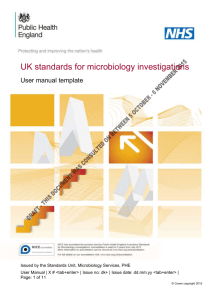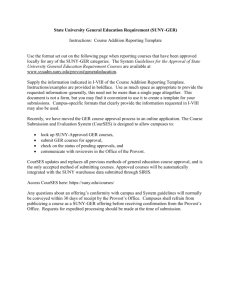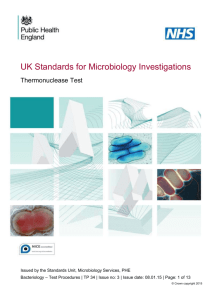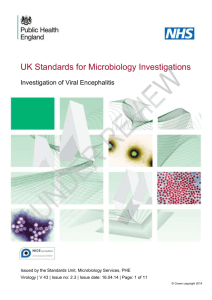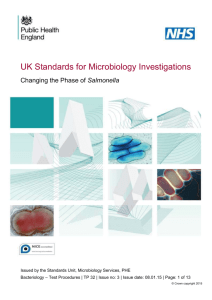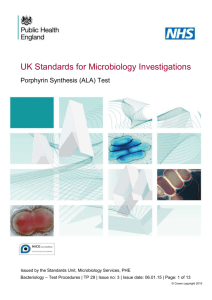User manual template draft
advertisement
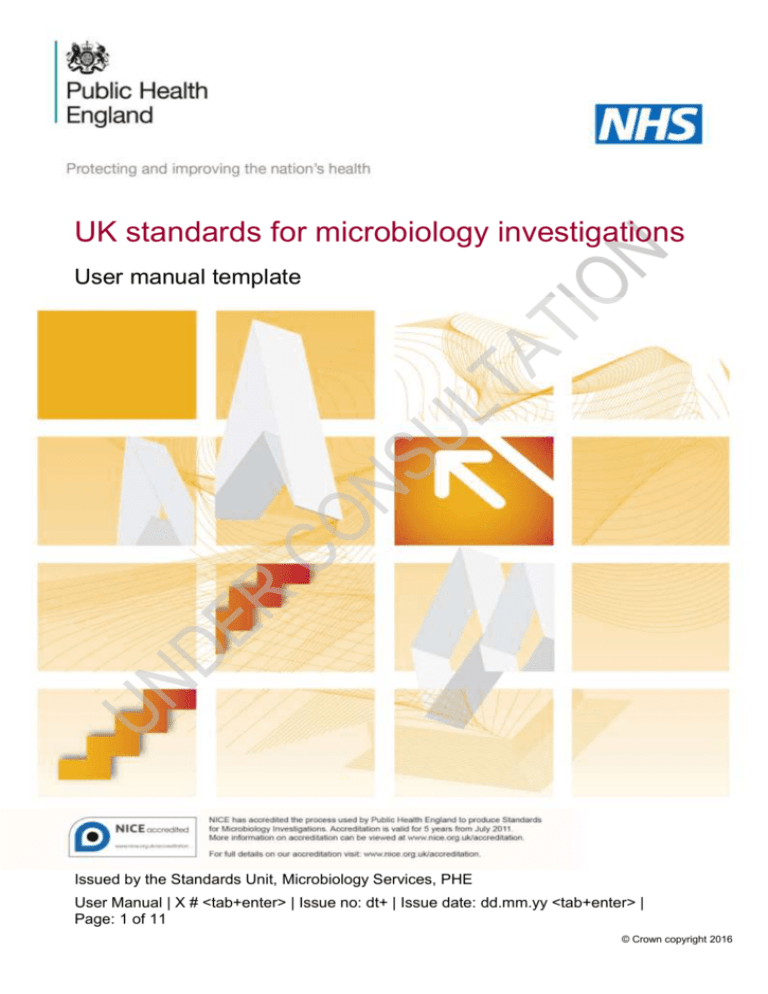
NUMWG-18/11/2015-P01 UK standards for microbiology investigations User manual template Issued by the Standards Unit, Microbiology Services, PHE User Manual | X # <tab+enter> | Issue no: dt+ | Issue date: dd.mm.yy <tab+enter> | Page: 1 of 11 © Crown copyright 2016 User manual template Acknowledgments UK Standards for Microbiology Investigations (SMIs) are developed under the auspices of Public Health England (PHE) working in partnership with the National Health Service (NHS), Public Health Wales and with the professional organisations whose logos are displayed below and listed on the website https://www.gov.uk/ukstandards-for-microbiology-investigations-smi-quality-and-consistency-in-clinicallaboratories. SMIs are developed, reviewed and revised by various working groups which are overseen by a steering committee (see https://www.gov.uk/government/groups/standards-for-microbiology-investigationssteering-committee). The contributions of many individuals in clinical, specialist and reference laboratories who have provided information and comments during the development of this document are acknowledged. We are grateful to the medical editors for editing the medical content. For further information please contact us at: Standards Unit Microbiology Services Public Health England 61 Colindale Avenue London NW9 5EQ E-mail: standards@phe.gov.uk Website: https://www.gov.uk/uk-standards-for-microbiology-investigations-smi-qualityand-consistency-in-clinical-laboratories PHE Publication gateway number: 2015368 UK Standards for Microbiology Investigations are produced in association with: Logos correct at time of publishing. User manual | X # <tab+enter> | Issue no: dt+ | Issue date: dd.mm.yy <tab+enter> | Page: 2 of 11 UK Standards for Microbiology Investigations | Issued by the Standards Unit, Public Health England User manual template Contents ACKNOWLEDGMENTS .......................................................................................................... 2 CONTENTS ............................................................................................................................. 3 AMENDMENT TABLE ............................................................................................................. 4 UK SMI: SCOPE AND PURPOSE ........................................................................................... 5 USER MANUAL TEMPLATE - BACKGROUND ..................................................................... 7 USER MANUAL TEMPLATE .................................................................................................. 7 REFERENCES ...................................................................................................................... 11 User manual | X # <tab+enter> | Issue no: dt+ | Issue date: dd.mm.yy <tab+enter> | Page: 3 of 11 UK Standards for Microbiology Investigations | Issued by the Standards Unit, Public Health England User manual template Amendment table Each SMI method has an individual record of amendments. The current amendments are listed on this page. The amendment history is available from standards@phe.gov.uk. New or revised documents should be controlled within the laboratory in accordance with the local quality management system. Amendment no/date. New amendment number/dd.mm.yy <tab+enter> Issue no. discarded. #.# <tab+enter> Insert issue no. #.# <tab+enter> Section(s) involved Amendment Amendment no/date. # <tab+enter>/dd.mm.yy <tab+enter> Issue no. discarded. #.# <tab+enter> Insert issue no. #.# <tab+enter> Section(s) involved Amendment Xxxxxx Xxxxxx Xxxxxxx Xxxxxx Xxxxxxx xxxxxx User manual | X # <tab+enter> | Issue no: dt+ | Issue date: dd.mm.yy <tab+enter> | Page: 4 of 11 UK Standards for Microbiology Investigations | Issued by the Standards Unit, Public Health England User manual template UK SMI: scope and purpose Users of SMIs Primarily, SMIs are intended as a general resource for practising professionals operating in the field of laboratory medicine and infection specialties in the UK. SMIs also provide clinicians with information about the available test repertoire and the standard of laboratory services they should expect for the investigation of infection in their patients, as well as providing information that aids the electronic ordering of appropriate tests. The documents also provide commissioners of healthcare services with the appropriateness and standard of microbiology investigations they should be seeking as part of the clinical and public health care package for their population. Background to SMIs SMIs comprise a collection of recommended algorithms and procedures covering all stages of the investigative process in microbiology from the pre-analytical (clinical syndrome) stage to the analytical (laboratory testing) and post analytical (result interpretation and reporting) stages. Syndromic algorithms are supported by more detailed documents containing advice on the investigation of specific diseases and infections. Guidance notes cover the clinical background, differential diagnosis, and appropriate investigation of particular clinical conditions. Quality guidance notes describe laboratory processes which underpin quality, for example assay validation. Standardisation of the diagnostic process through the application of SMIs helps to assure the equivalence of investigation strategies in different laboratories across the UK and is essential for public health surveillance, research and development activities. Equal partnership working SMIs are developed in equal partnership with PHE, NHS, Royal College of Pathologists and professional societies. The list of participating societies may be found at https://www.gov.uk/uk-standards-for-microbiology-investigations-smi-qualityand-consistency-in-clinical-laboratories. Inclusion of a logo in an SMI indicates participation of the society in equal partnership and support for the objectives and process of preparing SMIs. Nominees of professional societies are members of the Steering Committee and working groups which develop SMIs. The views of nominees cannot be rigorously representative of the members of their nominating organisations nor the corporate views of their organisations. Nominees act as a conduit for two way reporting and dialogue. Representative views are sought through the consultation process. SMIs are developed, reviewed and updated through a wide consultation process. Quality assurance NICE has accredited the process used by the SMI working groups to produce SMIs. The accreditation is applicable to all guidance produced since October 2009. The process for the development of SMIs is certified to ISO 9001:2008. SMIs represent a good standard of practice to which all clinical and public health microbiology Microbiology is used as a generic term to include the two GMC-recognised specialties of Medical Microbiology (which includes Bacteriology, Mycology and Parasitology) and Medical Virology. User manual | X # <tab+enter> | Issue no: dt+ | Issue date: dd.mm.yy <tab+enter> | Page: 5 of 11 UK Standards for Microbiology Investigations | Issued by the Standards Unit, Public Health England User manual template laboratories in the UK are expected to work. SMIs are NICE accredited and represent neither minimum standards of practice nor the highest level of complex laboratory investigation possible. In using SMIs, laboratories should take account of local requirements and undertake additional investigations where appropriate. SMIs help laboratories to meet accreditation requirements by promoting high quality practices which are auditable. SMIs also provide a reference point for method development. The performance of SMIs depends on competent staff and appropriate quality reagents and equipment. Laboratories should ensure that all commercial and in-house tests have been validated and shown to be fit for purpose. Laboratories should participate in external quality assessment schemes and undertake relevant internal quality control procedures. Patient and public involvement The SMI working groups are committed to patient and public involvement in the development of SMIs. By involving the public, health professionals, scientists and voluntary organisations the resulting SMI will be robust and meet the needs of the user. An opportunity is given to members of the public to contribute to consultations through our open access website. Information governance and equality PHE is a Caldicott compliant organisation. It seeks to take every possible precaution to prevent unauthorised disclosure of patient details and to ensure that patient-related records are kept under secure conditions. The development of SMIs is subject to PHE Equality objectives https://www.gov.uk/government/organisations/public-healthengland/about/equality-and-diversity. The SMI working groups are committed to achieving the equality objectives by effective consultation with members of the public, partners, stakeholders and specialist interest groups. Legal statement While every care has been taken in the preparation of SMIs, PHE and any supporting organisation, shall, to the greatest extent possible under any applicable law, exclude liability for all losses, costs, claims, damages or expenses arising out of or connected with the use of an SMI or any information contained therein. If alterations are made to an SMI, it must be made clear where and by whom such changes have been made. The evidence base and microbial taxonomy for the SMI is as complete as possible at the time of issue. Any omissions and new material will be considered at the next review. These standards can only be superseded by revisions of the standard, legislative action, or by NICE accredited guidance. SMIs are Crown copyright which should be acknowledged where appropriate. Suggested citation for this document Public Health England. (YYYY <tab+enter>). User manual template. UK Standards for Microbiology Investigations. X # <tab+enter> Issue #.# <tab+enter>. https://www.gov.uk/uk-standards-for-microbiology-investigations-smi-quality-andconsistency-in-clinical-laboratories User manual | X # <tab+enter> | Issue no: dt+ | Issue date: dd.mm.yy <tab+enter> | Page: 6 of 11 UK Standards for Microbiology Investigations | Issued by the Standards Unit, Public Health England User manual template User manual template - background The user manual template has been developed by an SMI joint working group of microbiologists. The group was convened to develop a national standard template to help microbiology service providers to produce a comprehensive, evidence based user manual. The user manual is intended as a general resource for practising professionals. Although not intended for public and patient groups, they may find the user manual a useful source of information. There may be duplications within the document but this is so as to emphasise some points. The ISO standards should be used in conjunction with this template. User manual template Please see below the proposed template for a user manual. Introduction and scope You may wish to include the following: a profile of the laboratory; provide a synopsis of your laboratory services and the accreditation status of the laboratory. explain who the intended user of the document is and what it does and does not cover (eg does not cover treatment or infection control). If further relevant documents exist, consider listing them here. Be clear whether this is for patient use or not. information relating to Notification of Infectious Diseases. Overview of services offered You may wish to include the following: identify specialist areas eg regional or national reference functions. Include diagnostic, clinical advice, infection control, infectious diseases, outbreaks, antibiotic stewardship, etc. confirmatory tests not directly requested may be performed by the laboratory if such tests aid interpretation of the initial test result (also known as reflex testing) – eg a failed HBV vaccine response allowably triggers a test for surface antigen of hepatitis B virus (HBsAg) provision and arrangement for accessing of immunoglobulins and vaccines (eg varicella-zoster immune globulin (VZIG), human normal immunoglobulin (HNIG), rabies prophylaxis) Contacting the laboratory You may wish to include the following: instructions on making enquiries for results and requests for additional tests on existing samples User manual | X # <tab+enter> | Issue no: dt+ | Issue date: dd.mm.yy <tab+enter> | Page: 7 of 11 UK Standards for Microbiology Investigations | Issued by the Standards Unit, Public Health England User manual template advice on how patients should obtain results; clearly explain whether patients should or should not call the laboratory directly for results – consideration should be given to data security and clinical risk contact details for key members of staff including availability times, email addresses of key members of staff, how to obtain results and clinical advice for out of hours service availability of clinical advice on ordering of examinations and interpretation of examination results Locating and accessing the laboratory You may wish to include the following: whether the public has access to the laboratory or not and where phlebotomy services are located location maps for both outside and inside the hospital if not contained in other documents specimen reception opening times and out of hours instructions working hours details of any out-of-hours service or shift system at the laboratory. Outline which services will always be provided and which will only be provided in consultation Collection and transport of specimens You may wish to include generic advice on collecting and transporting specimens and the following: procedures for the proper collection and handling of primary samples, including appropriate health and safety advice on labelling and transporting high risk samples such as blood samples for BBV, dengue as well as radioactive isotopes. References should be included as to why high risk samples should be labelled an explanation of any clinical procedure to be performed. Receipt of sample implies consent. Any specific requirements for patient consent (eg consent to disclose clinical information and family history to relevant healthcare professionals, where referral is needed). Provide a link to the trust consent policy. Patients should be made aware that any information provided may be transmitted onwards for further referral work patient information sheets (may refer use links) instructions for preparation for sample collection (eg instructions to caregivers, phlebotomists, sample collectors and patients) instructions on how to determine the identity of the patient from whom a primary sample is collected. Follow local policy on patient identification User manual | X # <tab+enter> | Issue no: dt+ | Issue date: dd.mm.yy <tab+enter> | Page: 8 of 11 UK Standards for Microbiology Investigations | Issued by the Standards Unit, Public Health England User manual template verification that the patient meets pre-examination requirements eg medication status (time of last dose or cessation), sample collection at a predetermined time (or time intervals) instructions for sample collectors, including instructions for patient-collected samples eg type and amount of the primary sample(s) to be collected with descriptions of the primary sample containers (pictures may be helpful) and any necessary additives; special timing of collection, where needed; clinical information relevant to or affecting sample collection, examination performance or result interpretation (eg history of administration of relevant drugs); information on how to order supplies of the relevant containers, forms, labels etc. This may be displayed in table format or images the identity of the person collecting the primary sample and the collection date, and, when needed, the collection time. True collection times should be mentioned and documented accordingly instructions for the safe disposal of materials used in the collection instructions for labelling of primary samples in a manner that provides an unequivocal link with the patients from whom they are collected for example instructions for proper storage conditions before collected samples are delivered to the laboratory and in a manner that ensures the integrity of the sample and safety for the carrier, general public and receiving laboratory, in compliance with established requirements. You should refer to the appropriate to the applicable ISO standard instructions for transportation of samples, including any special handling needs (such as high risk samples, radioactive isotopes, samples on dry ice). laboratory’s criteria for accepting and rejecting samples Test repertoire: You may wish to include the following: examinations offered by the laboratory. Include appropriate information concerning samples provided in general categories or for groups of related investigations (separate in-house and referred tests as separate tables), primary sample volumes, specific swab types eg for Chlamydia testing, special precautions, specific instructions for specimen collection and transportation, turnaround times (which may also be provided in general categories or for groups of examinations); procedures for medico-legal samples. Include relevant clinical algorithms with links to policies of local or national NHS organisations that are relevant the names and addresses of laboratories to which work is routinely referred a table to state the length of storage for samples that may need re-testing time limits for requesting additional examinations User manual | X # <tab+enter> | Issue no: dt+ | Issue date: dd.mm.yy <tab+enter> | Page: 9 of 11 UK Standards for Microbiology Investigations | Issued by the Standards Unit, Public Health England User manual template agree and insert table detailing A to Z of all syndromes and test types – add turnaround times Quality assurance and governance You may wish to include the quality assurance and governance structure for the laboratory; the complaints procedure; the laboratory’s policy on protection of personal information; and the fax and email policy. Ensuring the manual is consistent with the ISO guidance (reference the ISO guidance in this section) Also include a statement on the accreditation status, link to the accreditation body, and list of which (if any) tests are excluded from the accredited scope of practice (Accreditation status of test repertoire). Add information on validation/verification data Add information on compliance with Human Tissue Act Interpreting laboratory results You may wish to include relevant information on: biological reference intervals or clinical decision values (document their basis) a list of factors known to significantly affect the performance of the examination or the interpretation of the results (uncertainty of measurement) performance characteristics – sensitivity/specificity − of the tests pitfalls of serology, PCR, culture etc. As well as having such things embedded within individual tests, consider including passively acquired antibody, cross reactivates for IgM assays and sample quality (eg swabs and PCR results) costs of tests Reporting results You may wish to provide instructions for making results enquiries, including the minimum time required before phoning for a test result unless the sample has been marked as urgent. It is always advisable to check the LIMs system before phoning for results. Also include information relating to report categories (interim, final, amended) User manual | X # <tab+enter> | Issue no: dt+ | Issue date: dd.mm.yy <tab+enter> | Page: 10 of 11 UK Standards for Microbiology Investigations | Issued by the Standards Unit, Public Health England User manual template References User manual | X # <tab+enter> | Issue no: dt+ | Issue date: dd.mm.yy <tab+enter> | Page: 11 of 11 UK Standards for Microbiology Investigations | Issued by the Standards Unit, Public Health England
